The soil health nano-sensors industry stands at the threshold of a decade-long expansion trajectory that promises to reshape precision agriculture infrastructure and sustainable farming technology. The market's journey from USD 2,048.1 million in 2025 to USD 3,069.5 million by 2035 represents substantial growth, demonstrating the accelerating adoption of advanced soil monitoring systems and precision agriculture solutions across row crops, specialty horticulture, and agricultural research sectors.
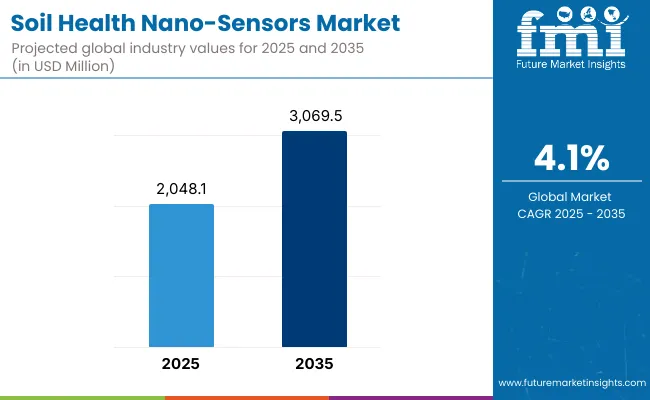
Soil Health Nano-Sensors Market Key Takeaways
| Metric | Value |
|---|---|
| Market Value (2025) | USD 2,048.1 million |
| Market Forecast (2035) | USD 3,069.5 million |
| Growth Rate | 4.1% CAGR |
| Leading Product Type | In-ground Probes |
| Primary Customer | Row Crops Segment |
The first half of the decade (2025-2030) will witness the market climbing from USD 2,048.1 million to approximately USD 2,204.7 million, adding USD 156.6 million in value, which constitutes 15% of the total forecast growth period. This phase will be characterized by the rapid adoption of in-ground probe systems, driven by increasing precision agriculture awareness and soil health monitoring demands worldwide. Advanced moisture sensing capabilities and IoT connectivity features will become standard expectations rather than premium options.
The latter half (2030-2035) will witness sustained growth from USD 2,204.7 million to USD 3,069.5 million, representing an addition of USD 864.8 million or 85% of the decade's expansion. This period will be defined by mass market penetration of connected sensor networks, integration with comprehensive farm management platforms, and seamless compatibility with existing agricultural infrastructure. The market trajectory signals fundamental shifts in how agricultural operations approach precision farming solutions, with participants positioned to benefit from sustained demand across multiple crop applications.
The Soil Health Nano-Sensors market demonstrates distinct growth phases with varying market characteristics and competitive dynamics. Between 2025 and 2030, the market progresses through its technology adoption phase, expanding from USD 2,048.1 million to USD 2,204.7 million with steady annual increments averaging 1.5% growth. This period showcases the transition from basic soil monitoring systems to advanced sensor networks with enhanced data analytics capabilities and integrated connectivity systems becoming mainstream features.
The 2025-2030 phase adds USD 156.6 million to market value, representing 15% of total decade expansion. Market maturation factors include standardization of sensor protocols, declining component costs for nano-sensor arrays, and increasing farm awareness of precision agriculture benefits reaching 85-90% effectiveness in soil monitoring applications. Competitive landscape evolution during this period features established manufacturers like METER Group expanding their sensor portfolios while new entrants focus on specialized connectivity solutions and enhanced data analytics.
From 2030 to 2035, market dynamics shift toward advanced integration and large-scale deployment, with growth accelerating from USD 2,204.7 million to USD 3,069.5 million, adding USD 864.8 million or 85% of total expansion. This phase transition logic centers on comprehensive farm management systems, integration with agricultural automation networks, and deployment across diverse farming scenarios, becoming standard rather than specialized applications. The competitive environment matures with focus shifting from basic sensing capability to comprehensive soil health management systems and integration with crop optimization platforms.
The market demonstrates strong fundamentals with in-ground probe systems capturing a dominant 55% share through advanced soil monitoring and precision agriculture capabilities. Row Crops applications drive primary demand with 45% market share, supported by increasing farm spending on precision agriculture systems and soil health management solutions. Geographic expansion remains concentrated in developed markets with established agricultural infrastructure, while emerging economies show accelerating adoption rates driven by agricultural modernization and rising precision farming awareness.
The soil health nano-sensors market represents a compelling intersection of precision agriculture, farm modernization, and sustainable farming practices. With robust growth projected from USD 2,048.1 million in 2025 to USD 3,069.5 million by 2035 at a 4.1% CAGR, this market is driven by increasing precision agriculture adoption, agricultural infrastructure upgrades, and regulatory pressures for sustainable farming practices.
The market's expansion reflects a fundamental shift in how agricultural operations approach soil health monitoring infrastructure. Strong growth opportunities exist across diverse applications, from row crop operations requiring reliable soil data to specialty horticulture facilities demanding advanced monitoring standards. Geographic expansion is particularly pronounced in Asia-Pacific markets, led by China (4.7% CAGR) and India (4.4% CAGR), while established markets in North America and Europe drive premium positioning and technology innovation.
The dominance of in-ground probe systems and row crops applications underscores the importance of proven sensor technology and operational reliability in driving adoption. Installation complexity and agricultural infrastructure compatibility remain key challenges, creating opportunities for companies that can simplify deployment while maintaining performance standards.
Market expansion rests on three fundamental shifts driving adoption across agricultural and research sectors. 1. Precision agriculture demand creates compelling operational advantages through soil health nano-sensors that provide real-time soil monitoring without manual intervention, enabling farms to optimize irrigation and fertilization while maintaining crop yields and reducing operational costs. 2. Agricultural modernization programs accelerate as farm operators worldwide seek advanced monitoring systems that complement existing equipment, enabling precise soil management solutions that align with sustainability goals and regulatory requirements. 3. Agricultural infrastructure enhancement drives adoption from row crop and specialty horticulture operations requiring effective soil monitoring that minimizes crop risk while maintaining productivity during critical growing seasons.
However, growth faces headwinds from installation complexity challenges that vary across farm types regarding existing infrastructure integration and connectivity requirements, potentially limiting deployment flexibility in certain agricultural environments. Technical limitations also persist regarding sensor accuracy and maintenance intervals that may increase operational costs in large-scale applications with demanding precision standards.
Primary Classification: The market segments by product type into In-ground Probes, Handheld Meters, Lab-on-Chip, Drone/Edge kits, and other categories, representing the evolution from basic soil testing systems to comprehensive monitoring solutions for advanced agricultural applications.
Secondary Breakdown: Parameter segmentation divides the market into Moisture, Nitrate/Ions, Salinity/EC, pH, and other measurements, reflecting distinct requirements for crop optimization, irrigation management, and soil health assessment.
Tertiary Classification: Customer segmentation covers Row Crops, Specialty Horticulture, Turf/Golf, Research/Others sectors, with different applications leading adoption while diverse agricultural segments show accelerating implementation driven by precision farming programs.
Connectivity Classification: Technology segmentation includes LoRaWAN, Cellular/NB-IoT, Wired, Bluetooth/Short, and other connectivity options, representing distinct approaches to data transmission, farm integration, and operational monitoring.
Regional Classification: Geographic distribution covers North America, Europe, Asia Pacific, Latin America, and the Middle East & Africa, with developed markets leading adoption while emerging economies show accelerating growth patterns driven by agricultural modernization programs.
The segmentation structure reveals technology progression from basic in-ground monitoring toward integrated sensor networks with enhanced connectivity and farm management capabilities, while application diversity spans from row crop operations to research facilities requiring precise soil monitoring solutions.
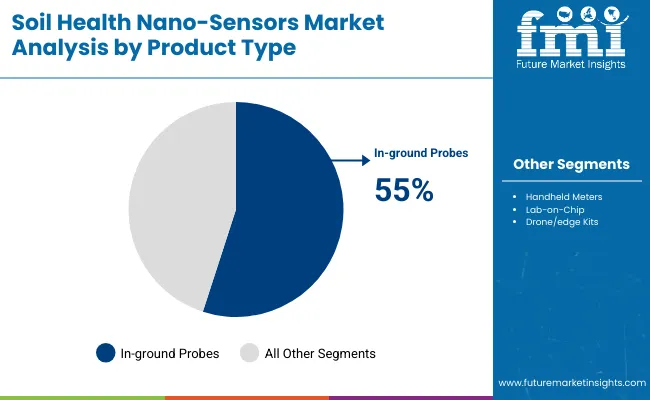
Market Position: In-ground Probes systems command the leading position in the Soil Health Nano-Sensors market with 55% market share through advanced monitoring features, including comprehensive soil parameter measurement, extended deployment capability, and cost-effective maintenance that enable farms to deploy precision agriculture solutions across diverse crop environments.
Value Drivers: The segment benefits from farm preference for proven sensor technology that provides immediate soil monitoring improvement without requiring complex infrastructure modifications. Reliable design features enable deployment in agricultural environments, research facilities, and specialty crop applications where accuracy and durability represent critical operational requirements.
Competitive Advantages: In-ground probe systems differentiate through continuous monitoring capability, proven sensor performance, and integration with standard farm management systems that enhance agricultural precision while maintaining cost-effective operational profiles suitable for diverse crop applications.
Key market characteristics
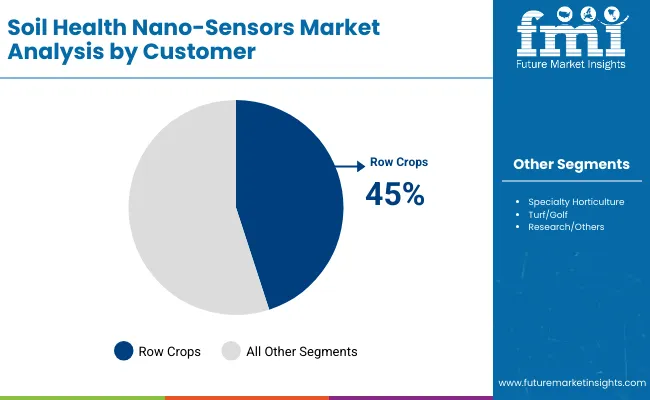
Market Context: Row Crops applications dominate the Soil Health Nano-Sensors market with 45% share due to widespread adoption of precision agriculture systems and increasing focus on soil optimization, yield management, and sustainable farming applications that maximize crop productivity while maintaining operational efficiency.
Appeal Factors: Row crop customers prioritize system reliability, data accuracy, and integration with existing farm infrastructure that enables coordinated deployment across multiple field locations. The segment benefits from substantial precision agriculture budgets and modernization programs that emphasize data-driven farming for crop production and yield optimization operations.
Growth Drivers: Agricultural modernization programs incorporate soil sensors as standard equipment for precision farming and yield optimization applications. At the same time, sustainable agriculture initiatives are increasing demand for soil monitoring systems that comply with environmental standards and minimize resource waste.
Market Challenges: Installation requirements and farm compatibility issues may limit deployment flexibility in certain crop types or existing infrastructure scenarios.
Customer dynamics include
Growth Accelerators: Agricultural modernization drives primary adoption as soil health nano-sensors provide precision monitoring capabilities that enable real-time soil assessment without manual sampling, supporting crop optimization and resource efficiency that require accurate soil management. Farming infrastructure demand accelerates market expansion as agricultural operators seek effective monitoring solutions that minimize crop risk while maintaining productivity during critical growing seasons and farm operations. Precision agriculture spending increases worldwide, creating sustained demand for sensor systems that complement existing equipment and provide operational insights in complex farming environments.
Growth Inhibitors: Installation complexity challenges vary across farm types regarding existing infrastructure compatibility and connectivity requirements, which may limit deployment flexibility and market penetration in operations with restrictive technology modifications. Technical performance limitations persist regarding sensor calibration and data accuracy that may increase operational costs in large-scale applications with demanding precision standards and continuous monitoring patterns. Market fragmentation across multiple agricultural standards and connectivity protocols creates compatibility concerns between different sensor manufacturers and existing farm infrastructure.
Market Evolution Patterns: Adoption accelerates in agricultural and research sectors where precision soil monitoring justifies system costs, with geographic concentration in developed markets transitioning toward mainstream adoption in emerging economies driven by agricultural modernization and farming infrastructure development. Technology development focuses on enhanced sensor capabilities, improved connectivity technology, and integration with farm management systems that optimize crop planning and resource allocation monitoring. The market could face disruption if alternative monitoring technologies or regulatory restrictions significantly limit soil sensor deployment in agricultural or research applications.
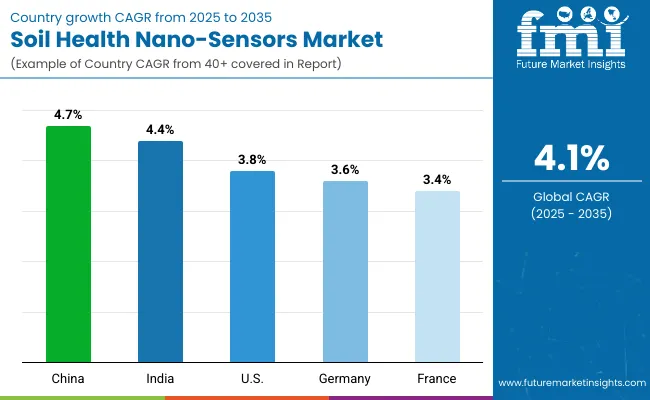
| Country | CAGR (2025 to 2035) |
|---|---|
| China | 4.7% |
| India | 4.4% |
| UK | 3.8% |
| Germany | 3.6% |
| France | 3.4% |
The Soil Health Nano-Sensors market demonstrates varied regional dynamics with Growth Leaders including China (4.7% CAGR) and India (4.4% CAGR) driving expansion through agricultural modernization and precision farming infrastructure development. Steady Performers encompass the USA (3.8% CAGR), Germany (3.6% CAGR), and France (3.4% CAGR), benefiting from established agricultural sectors and advanced precision farming adoption. These countries demonstrate consistent growth patterns through mature farming infrastructure and comprehensive agricultural technology integration programs.
Regional synthesis reveals Asia-Pacific markets leading growth through agricultural modernization and precision farming infrastructure development, while European and North American countries maintain steady expansion supported by advanced agricultural technology and farm modernization requirements. Global markets show consistent adoption driven by precision agriculture and sustainable farming trends.
China establishes market leadership through aggressive agricultural modernization programs and comprehensive precision farming infrastructure development, integrating advanced soil health nano-sensors as standard components in row crops and specialty agriculture applications. The country's 4.7% CAGR through 2035 reflects government initiatives promoting agricultural technology and domestic farming capabilities that mandate the use of precision monitoring systems in agricultural and research installations. Growth concentrates in major agricultural regions, including Heilongjiang, Shandong, and Henan provinces, where farm modernization showcases integrated sensor systems that appeal to domestic operators seeking advanced crop optimization solutions and agricultural efficiency applications.
Chinese manufacturers are developing cost-effective soil sensor solutions that combine domestic production advantages with advanced features, including multi-parameter monitoring systems and extended operational capacity.
Strategic Market Indicators
In agricultural regions including Punjab, Haryana, and Maharashtra, farming operations are implementing advanced soil health nano-sensors as standard equipment for precision agriculture and crop optimization applications, driven by increasing agricultural spending and modernization programs that emphasize precision farming capabilities. The market is projected to demonstrate a 4.4% CAGR through 2035, supported by government agricultural initiatives and farming infrastructure development programs that promote advanced monitoring systems for crop production and research facilities. Indian agricultural operators are adopting soil sensor systems that provide reliable crop monitoring and precision farming features, particularly appealing in agricultural developments where crop optimization represents critical operational requirements.
Market expansion benefits from growing agricultural technology capabilities and international technology transfer agreements that enable domestic production of advanced sensor systems for farming and research applications.
Market Intelligence Brief
Germany's advanced agricultural technology market demonstrates sophisticated soil health nano-sensor deployment with documented operational effectiveness in specialty crops and research applications through integration with existing farm management systems and agricultural infrastructure. The country leverages engineering expertise in sensor technology and precision agriculture integration to maintain a 3.6% CAGR through 2035. Agricultural centers, including Bavaria, Lower Saxony, and North Rhine-Westphalia, showcase premium installations where soil sensors integrate with comprehensive farm platforms and agricultural management systems to optimize crop production and precision farming effectiveness.
German agricultural contractors prioritize system reliability and environmental compliance in soil sensor development, creating demand for premium systems with advanced features, including enhanced sensor durability and integration with precision agriculture systems. The market benefits from established agricultural infrastructure and a willingness to invest in advanced precision technologies that provide long-term operational benefits and compliance with environmental regulations.
Market Intelligence Brief
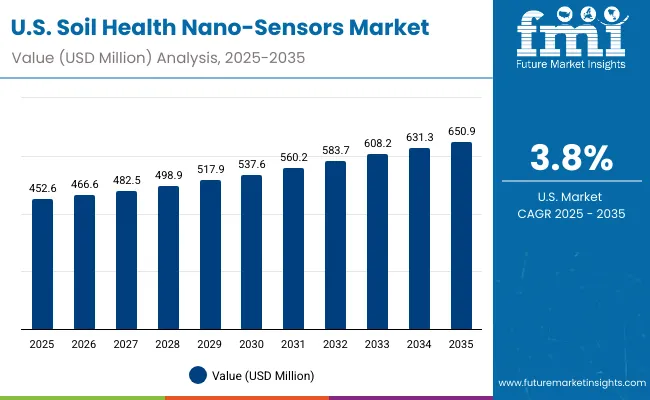
The USA market emphasizes advanced soil health nano-sensor features, including precision monitoring systems and integration with comprehensive farm management platforms that manage soil health, crop planning, and irrigation optimization applications through unified agricultural systems. The country is projected to show a 3.8% CAGR through 2035, driven by farm modernization under agricultural equipment upgrades and research demand for reliable, precision monitoring systems. American agricultural operators prioritize operational effectiveness with soil sensors delivering consistent performance through advanced monitoring algorithms and farm management capabilities.
Technology deployment channels include major agricultural equipment suppliers, specialized precision agriculture companies, and research procurement programs that support professional installation for complex farming applications.
Performance Metrics
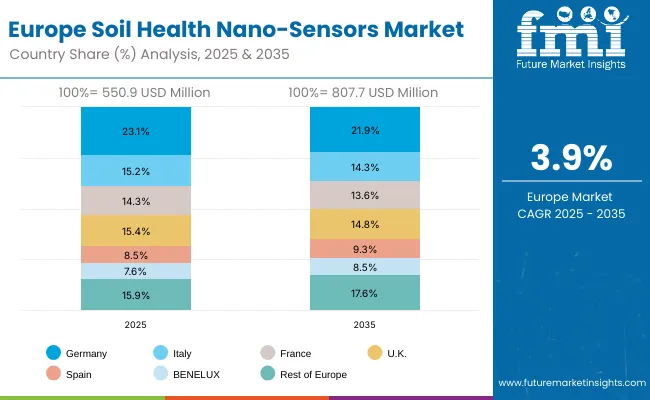
The Soil Health Nano-Sensors market in Europe is projected to grow from USD 550.9 million in 2025 to USD 807.7 million by 2035, registering a CAGR of 3.9% over the forecast period. Germany is expected to maintain its leadership position with a 23.1% market share in 2025, declining slightly to 21.9% by 2035, supported by its advanced agricultural infrastructure and major precision farming centers, including Bavaria and Lower Saxony.
Italy follows with a 15.2% share in 2025, projected to reach 14.3% by 2035, driven by comprehensive agricultural modernization programs and precision farming development initiatives. France holds a 14.3% share in 2025, expected to maintain 13.6% by 2035 through specialized agricultural applications and environmental compliance requirements. UK commands a 15.4% share, while Spain accounts for 8.5% in 2025. The Rest of Europe region is anticipated to gain momentum, expanding its collective share from 15.9% to 17.6% by 2035, attributed to increasing soil sensor adoption in Nordic countries and emerging Eastern European agricultural facilities implementing precision farming programs.
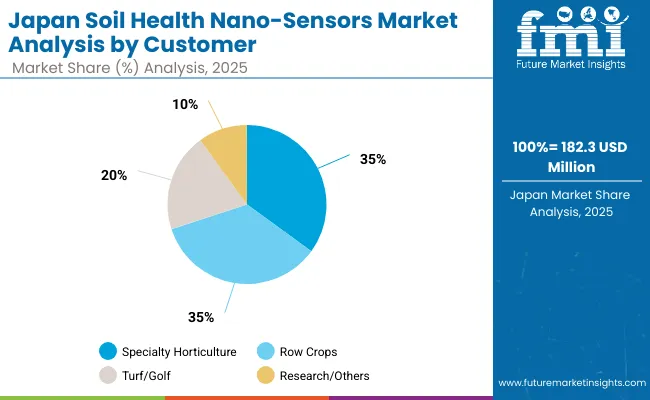
In Japan, the Soil Health Nano-Sensors market prioritizes LoRaWAN connectivity systems, which capture significant market share of agricultural and research installations through advanced features, including long-range communication optimization and seamless integration with existing farm management infrastructure. Japanese agricultural operators emphasize reliability, connectivity range, and long-term operational excellence, creating demand for LoRaWAN systems that provide precision agriculture capabilities and adaptive network control based on operational requirements and farm scenarios. Cellular/NB-IoT systems maintain a secondary market position primarily in specialized applications and research installations where enhanced data transmission functionality meets operational requirements without complex network management features.
Market Characteristics
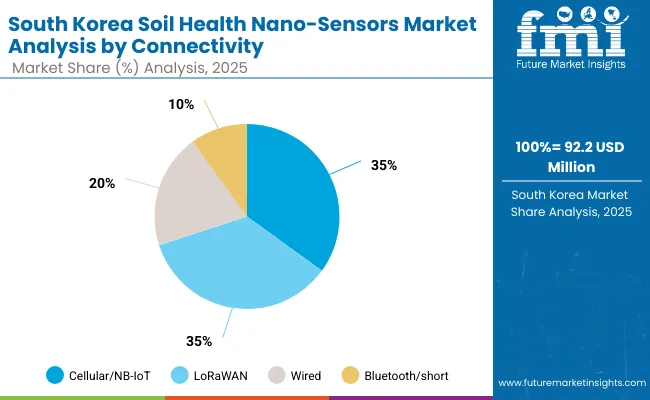
In South Korea, the market structure favors international sensor companies, including METER Group, AquaSpy, and Campbell Scientific, which maintain dominant positions through comprehensive product portfolios and established agricultural procurement networks supporting both farming and research installations. These providers offer integrated solutions combining advanced soil sensor systems with professional installation services and ongoing technical support that appeal to Korean agricultural operators seeking reliable, precision monitoring systems.
Local agricultural contractors and system integrators capture moderate market share by providing localized service capabilities and competitive pricing for standard farm installations. At the same time, domestic manufacturers focus on specialized applications and cost-effective solutions tailored to Korean agricultural characteristics.
Channel Insights
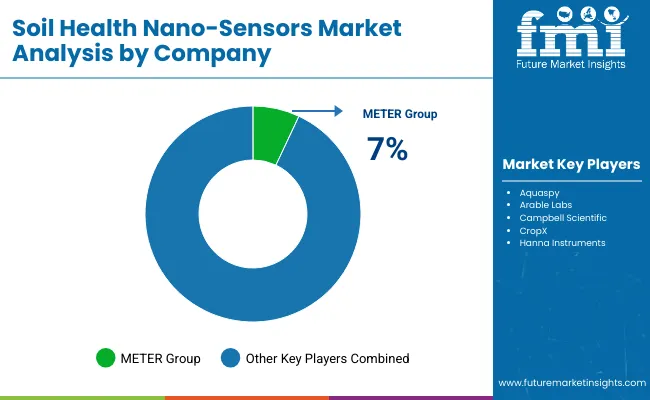
The Soil Health Nano-Sensors market operates with moderate concentration, featuring approximately 12-18 meaningful participants, where leading companies control roughly 30-35% of the global market share through established agricultural facility relationships and comprehensive technology portfolios. Competition emphasizes advanced sensor capabilities, system reliability, and farm integration rather than price-based rivalry.
Market Leaders encompass METER Group, AquaSpy, and Campbell Scientific, which maintain competitive advantages through extensive precision agriculture expertise, global agricultural equipment networks, and comprehensive system integration capabilities that create customer switching costs and support premium pricing. These companies leverage decades of agricultural sensor experience and ongoing research investments to develop advanced soil monitoring systems with enhanced connectivity and farm management features.
Technology Challengers include Arable Labs, CropX, and Hanna Instruments, which compete through specialized sensor technology focus and innovative connectivity interfaces that appeal to agricultural customers seeking advanced monitoring capabilities and operational flexibility. These companies differentiate through rapid technology development cycles and specialized agricultural application focus.
Market dynamics favor participants that combine reliable sensor hardware with advanced data analytics software, including crop optimization tracking and predictive farming capabilities. Competitive pressure intensifies as traditional agricultural equipment manufacturers expand into precision monitoring systems. At the same time, specialized sensor companies challenge established players through innovative monitoring solutions and cost-effective platforms targeting specialized agricultural segments.
| Item | Value |
|---|---|
| Quantitative Units | USD 2,048.1 Million |
| Product Type | In-ground Probes, Handheld Meters, Lab-on-Chip, Drone/Edge kits, Others |
| Parameter | Moisture, Nitrate/Ions, Salinity/EC, pH, Others |
| Customer | Row Crops, Specialty Horticulture, Turf/Golf, Research/Others |
| Connectivity | LoRaWAN, Cellular/NB- IoT, Wired, Bluetooth/Short, Others |
| Regions Covered | North America, Europe, Asia Pacific, Latin America, Middle East & Africa |
| Countries Covered | China, India, Germany, the USA, France, the UK, Japan, and 25+ additional countries |
| Key Companies Profiled | METER Group, AquaSpy, Arable Labs, Campbell Scientific, CropX, Hanna Instruments |
| Additional Attributes | Dollar sales by product type and customer categories, regional adoption trends across North America, Europe, and Asia-Pacific, competitive landscape with sensor manufacturers and technology providers, farm preferences for monitoring accuracy and system reliability, integration with agricultural management platforms and precision farming systems, innovations in sensor technology and connectivity efficiency, and development of IoT solutions with enhanced monitoring and analytics capabilities. |
The market will grow from USD 2,048.1 million in 2025 to USD 3,069.5 million in 2035, at a CAGR of 4.1%.
In-ground probes lead with a 55% market share in 2025, driven by their reliability and continuous monitoring capabilities.
The Row Crops segment represents 45% of demand, as large-scale farms and cooperatives adopt precision agriculture systems.
Adoption is driven by precision agriculture programs, agricultural modernization, and the need for sustainable soil health monitoring in crop optimization.






Our Research Products

The "Full Research Suite" delivers actionable market intel, deep dives on markets or technologies, so clients act faster, cut risk, and unlock growth.

The Leaderboard benchmarks and ranks top vendors, classifying them as Established Leaders, Leading Challengers, or Disruptors & Challengers.

Locates where complements amplify value and substitutes erode it, forecasting net impact by horizon

We deliver granular, decision-grade intel: market sizing, 5-year forecasts, pricing, adoption, usage, revenue, and operational KPIs—plus competitor tracking, regulation, and value chains—across 60 countries broadly.

Spot the shifts before they hit your P&L. We track inflection points, adoption curves, pricing moves, and ecosystem plays to show where demand is heading, why it is changing, and what to do next across high-growth markets and disruptive tech

Real-time reads of user behavior. We track shifting priorities, perceptions of today’s and next-gen services, and provider experience, then pace how fast tech moves from trial to adoption, blending buyer, consumer, and channel inputs with social signals (#WhySwitch, #UX).

Partner with our analyst team to build a custom report designed around your business priorities. From analysing market trends to assessing competitors or crafting bespoke datasets, we tailor insights to your needs.
Supplier Intelligence
Discovery & Profiling
Capacity & Footprint
Performance & Risk
Compliance & Governance
Commercial Readiness
Who Supplies Whom
Scorecards & Shortlists
Playbooks & Docs
Category Intelligence
Definition & Scope
Demand & Use Cases
Cost Drivers
Market Structure
Supply Chain Map
Trade & Policy
Operating Norms
Deliverables
Buyer Intelligence
Account Basics
Spend & Scope
Procurement Model
Vendor Requirements
Terms & Policies
Entry Strategy
Pain Points & Triggers
Outputs
Pricing Analysis
Benchmarks
Trends
Should-Cost
Indexation
Landed Cost
Commercial Terms
Deliverables
Brand Analysis
Positioning & Value Prop
Share & Presence
Customer Evidence
Go-to-Market
Digital & Reputation
Compliance & Trust
KPIs & Gaps
Outputs
Full Research Suite comprises of:
Market outlook & trends analysis
Interviews & case studies
Strategic recommendations
Vendor profiles & capabilities analysis
5-year forecasts
8 regions and 60+ country-level data splits
Market segment data splits
12 months of continuous data updates
DELIVERED AS:
PDF EXCEL ONLINE
Soil Erosion Testing Market Size and Share Forecast Outlook 2025 to 2035
Soil Moisture Sensor Market Size and Share Forecast Outlook 2025 to 2035
Soil Aerators Market Size and Share Forecast Outlook 2025 to 2035
Soil Hardening Agent Market Size and Share Forecast Outlook 2025 to 2035
Soil Field Testing Equipment Market Growth - Trends & Forecast 2025 to 2035
Soil Testing Market Growth - Trends & Forecast 2025 to 2035
Soil Stabilization Material Market Outlook 2025 to 2035
Soil Testing Kit Market Growth - Trends & Forecast 2025 to 2035
Soil Treatment Chemicals Market
Soil Inoculants Market
Soil Sampling Services Market
Soil Stabilizers Market
Soil Testing, Inspection, and Certification Market Growth – Forecast 2017-2027
Anti-Soiling Coating Market Growth - Trends & Forecast 2025 to 2035
Impact Soil Tester Market Size and Share Forecast Outlook 2025 to 2035
Silicon Soil Conditioner Market Analysis - Size and Share Forecast Outlook 2025 to 2035
Professional Potting Soil Market Size and Share Forecast Outlook 2025 to 2035
Healthcare Air Purifier Market Size and Share Forecast Outlook 2025 to 2035
Healthcare Regulatory Affairs Outsourcing Market Size and Share Forecast Outlook 2025 to 2035
Healthcare and Laboratory Label Industry Analysis in the United States Size and Share Forecast Outlook 2025 to 2035

Thank you!
You will receive an email from our Business Development Manager. Please be sure to check your SPAM/JUNK folder too.
Chat With
MaRIA